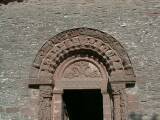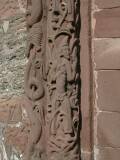 The small church in Kilpeck is a gem of romanesque architecture and
carving.
The small church in Kilpeck is a gem of romanesque architecture and
carving. The small church in Kilpeck is a gem of romanesque architecture and
carving.
The small church in Kilpeck is a gem of romanesque architecture and
carving.
Kilpeck is in Herefordshire, but it's close to the Welsh border and in the past was in Ergyng, or Archenfield, a buffer statelet, and thus Welsh rather than English. The name is probably derived from Welsh kil + Pedic (or Pedoric), the cell of St Ped(or)ic.
An older church stood on this site before the one we now see, and the present Church of St Mary and St David was built around 1140. The Roundheads (England's precursors of the Taliban) certainly visited Kilpeck but mysteriously seem to have ignored its church, which underwent restoration and maintenance work in the 1840s, and also in the 1890s (when the remains of frescoes were removed), 1962, and 1999. The mid-nineteenth-century contribution was unusually restrained, for which we should thank L. N. Cottingham.
I've been there at least three times, but it was only on 3 September 2000 that the weather cooperated and I had my camera. Here you have some photos of the exterior, and mostly the sunny side thereof. (The interior is almost as rewarding, but unfortunately I didn't have the lighting equipment -- or perhaps the skill -- needed for anything better than the most horrible photos.)
The north side of the church, and its belfry. The church has a "three-cell" structure; moving from left to right in the photo above, these are the semicircular apse, the chancel, and the nave. The belfry is actually nineteenth-century, but is done very well (by Cottingham). Well, there's nothing so very remarkable so far. (We find the same three-cell structure at Moccas, for example.) However:
 How's that for a doorway? Let's
take a closer look at the tympanum (the semicircular bit). If there's
something slightly odd about it, perhaps this is because what surrounds
it isn't quite aligned. I quote:
How's that for a doorway? Let's
take a closer look at the tympanum (the semicircular bit). If there's
something slightly odd about it, perhaps this is because what surrounds
it isn't quite aligned. I quote:
Considering the great skill of the carvers, it is surprising that the figures over the doorway are not centred: the middle larger voussoir is off-centre as is the 'Lamb of God' on the corbel above. There is a lack of symmetry throughout the church, both inside and out, which gives it a unique local Herefordshire quality. (Bailey 10-11)
And now let's move down.
 The lower of two warriors on the left-hand column. Both wear trousers (which
were unusual in those days) and soft caps, and although they are commonly
referred to as Welsh, they're a bit of a mystery.
The lower of two warriors on the left-hand column. Both wear trousers (which
were unusual in those days) and soft caps, and although they are commonly
referred to as Welsh, they're a bit of a mystery.
Back to the top again. There are fourteen carvings on the inner order of the arch (older and a lot more interesting than the outer order), and twelve of these -- all but the leftmost pair (a beak-head and a dragon) -- are photographed here: 3, manticore; 4, mask with two dragons' heads coming out of the mouth; 5, beak-head; 6, mask with two dragons' heads rising from out of the mouth; 7, phoenix; 8, angel with scroll at the centre; 9, mask with foliage coming from out of the mouth; 10, beak-head; 11, circle of four dragons each devouring the next; 12, dragon biting its tail; 13, dragon's head in profile; 14, beak-head.
There is a row of corbels around the church. Originally there were 89 of them, and although some have been mutilated or removed, most (even a sheela-na-gig) have survived in good condition. First, here they are in context.
And close up:
It's not at all clear what some of the corbels mean, but although they were added for didactic rather than entertainment value it's hard not to think that they provided enjoyment even when new. The fact that the ibex is upside down is very strong evidence that the Bestiary was a source, as the ibex
has two horns, which are so strong that if it falls from a high mountain down a precipice, its horns bear the whole weight of its body and it escapes unhurt. The beast represents those learned men who understand the harmony of the Old and New Testaments, and if anything untoward happens to them, they are supported as if on two horns by all the good they have derived from reading the witness of the Old Testament and the Gospels.
-- Bestiary, trans. R. Barber (Woodbridge, 1993), 45; qtd. Thurlby 58-9 (and this is a good example of the degree of detail and informativeness of Thurlby's book).
The church has three romanesque windows, of which this one, at the west, is by far the most intricate. On each side there's a design of an interlaced snake topped by a "green man".
Thurlby says, "The belfry belongs to Cottingham's restoration" (37). Pevsner says, "Cottingham's restoration of 1848 seems to have been a competent and disciplined job" (201). Bailey: "Much work, including the rebuilding of the bell-turret, was done by Cottingham in 1864 [sic]" (21). None identifies which Cottingham it was. There were two architect Cottinghams: Lewis Nockalls Cottingham (1787-1847) and his much less famous son Nockalls Johnson Cottingham (1823-1854); both of course were dead by 1864. Myles says that L. N. Cottingham's restoration work lasted from 1845-8, which seems to imply that some of it was posthumous; but she also says that N. J. Cottingham continued his father's restoration work elsewhere (13).
Sources and recommendations:
Any comments? Corrections? Bouquets? Write to me (Peter Evans), or tell the whole world.
First sellotaped together on 23 June 2001. Last fiddled with: 6 April 2004.